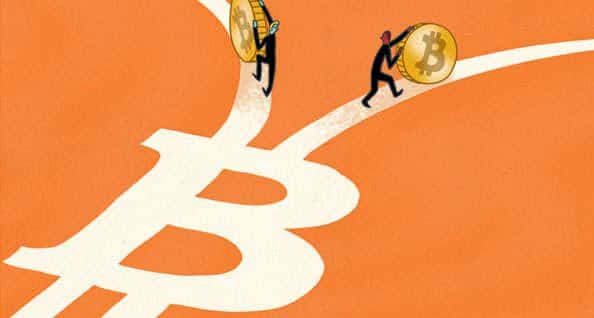Bitcoin and Bitcoin Cash in Limbo: Was the Blockchain Split Worth It?

The Bitcoin blockchain has been split in two. After many debates and rumors about what could be done to solve several issues with the cryptocurrency, it was agreed that a split of the Bitcoin blockchain would occur to tackle scalability issues.
This split resulted in two Bitcoin currencies, each with its own blockchain now: Bitcoin and Bitcoin Cash. Some have embraced Bitcoin Cash as a new cryptocurrency while others are dismissing it as a fad that will fizzle out soon. Then there are others claiming that this will do nothing to solve the imminent issues of Bitcoin.
As is always the case with cryptocurrencies, volatility is the only constant. Keep reading to get a sense of current events, expert opinions, and general sentiment over this polarizing move. Nobody knows what will happen, so it’s best to form your own opinion.
A Need for Speed
Before the split, Bitcoin transactions could be processed at a rate of only 1 megabyte at a time (every 10 minutes as discussed here). This eventually led to delays. Miners, the people responsible for creating more Bitcoins, could not keep up with the increase in popularity of the currency. Scalability issues were now shoved into the spotlight and could be avoided no longer.
For Bitcoin to continue its rapid expansion, the slow rate of transaction processing had to be fixed. Bitcoin miners tried to address it with a proposal known as SegWit2X. This proposal had two effects. First, it would introduce an optimization known as “segregated witness.” This would essentially move some of the processing data out of the bitcoin network to increase capacity. Second, SeqWit2X called for transaction block size (limit) to be increased to 2 MB.

Drastic Measures for Dire Situations
Many investors, exchanges, and miners were still discontent, stating that SeqWit2X was not enough. After more infighting, it was agreed that a user-activated hard fork (UAHF) would be completed to split the Bitcoin blockchain. The result would be a transaction limit of 8 MB and a new cryptocurrency, Bitcoin Cash, with its own blockchain.
The UAHF for the blockchain split began at 12:37 p.m., UTC, at block height 478558 of the Bitcoin blockchain. Investors with Bitcoin tokens should have received the same number of Bitcoin Cash tokens on the new blockchain. Bitcoin Cash was expected to only have a fraction of the worth of Bitcoin. But this was more of a reflection of the fact that it is a new cryptocurrency, not necessarily pessimism towards its future.
Different Sides of the Same Coin
Before, the debate in the Bitcoin community was about which solution would produce the best results. Post-split, the debate rages on but now focuses on if the measure taken was the correct one.

Sheffield Clark, CEO of Coinsource, a national Bitcoin ATM network, was blunt about his opinion regarding Bitcoin Cash. “When we look back 30 days from now, this is essentially going to be a non-event… We have absolutely no plans to integrate Bitcoin Cash at our machines at this time.”
The CEO of Dash Core, Ryan Taylor, had similar thoughts. He expressed skepticism over Bitcoin Cash being the solution for Bitcoin’s scaling problems. Dash is a digital currency that emphasizes privacy.
“While the markets will ultimately decide, I think there is little chance that Bitcoin Cash will be successful in the long-term. It may have increased capacity, but several issues remain.”
– Ryan Taylor
Luis Cuende, co-founder of the Aragon network, had a more balanced perspective to offer. He thinks the split “will positively impact Bitcoin,” but that Bitcoin Cash may have a short life. He suspects either a fatal bug will crash its network just as it did for its predecessor, Bitcoin Unlimited, or people will just lose interest.
ZenCash co-founder Rob Viglione and CryptoCompare founder Charles Hayter offered up more optimistic opinions. While admitting that it is bad for Bitcoin to lose part of its ecosystem, Viglione expressed his belief that the move could succeed. Hayter noted that instead of arguing with each other, now both sides of the debate had their own cryptocurrency and blockchain to apply their perspectives to.
“It’s more than possible to see both chains flourish in parallel.”
– Rob Viglione

A Fork in the Road of Bitcoin’s Future
It is still too soon to confirm whether the Bitcoin bifurcation was a success or failure. If Bitcoin Cash has piqued your interest, you’ll have to wait a while to be able to trade it. First, it must secure a sizeable amount of block confirmations and get through the initial adjustment hurdles that any new cryptocurrency must cross.
Besides this, each exchange has taken a different stance on Bitcoin Cash. Coinbase has announced that it should support Bitcoin Cash by January 1, 2018. Gemini, on the other hand, is working on a one-time withdrawal of Bitcoin Cash so customers can take the currency elsewhere.
Recently, Bitcoin skyrocketed to new heights of value around $3,400, nearly triple gold’s price. Bitcoin Cash plummeted but has been steadily recovering. Volatility is the key factor to remember with cryptocurrencies. Sentiments and values change in the blink of an eye. But that’s part of what makes cryptocurrencies so exciting.
Sources: Business Insider, USA Today, Futurism, coindesk, Bitcoin.com





